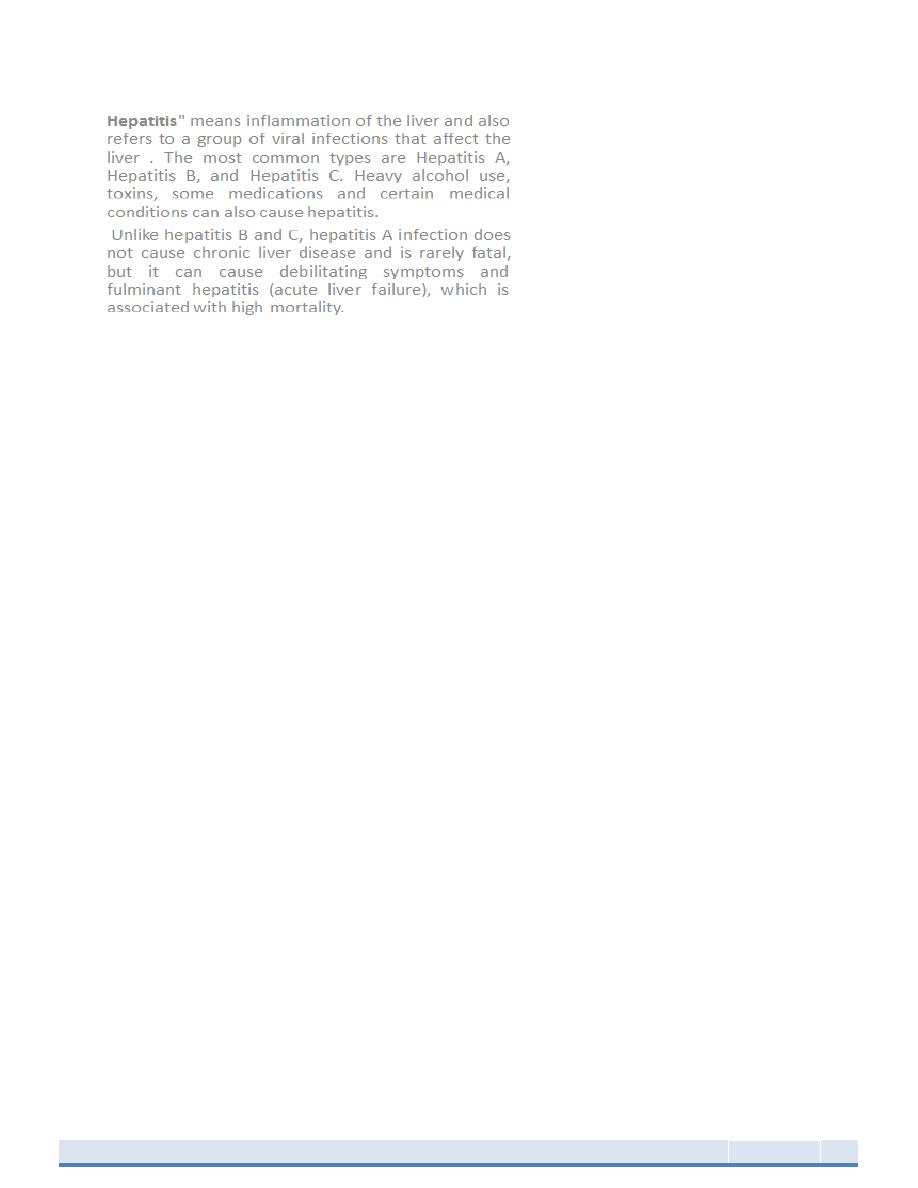
Community
1
•
What is the difference
between Hepatitis A, Hepatitis B,
and Hepatitis C?
•
Hepatitis A, Hepatitis B,
and Hepatitis C are diseases
caused by three different viruses.
Although each can cause similar
symptoms, they have different
modes of transmission and can
affect the liver differently.
•
Hepatitis A appears only as
an acute or newly occurring
infection and does not become
chronic. People with Hepatitis A
usually improve without
treatment.
•
Hepatitis B and Hepatitis C can also begin as acute infections, but in some people, the virus
remains in the body, resulting in chronic disease and long term liver problems. There are
vaccines to prevent Hepatitis A and B; however, there is not one for Hepatitis C. If a person
has had one type of viral hepatitis in the past, it is still possible to get the other types.
Hepatitis A
IDENTIFICATION
•
This is the type of hepatitis which was commonly referred to as infective hepatitis earlier.
Typical Cases
These occurs in three phases.
•
In the pre-icteric phase, fever, anorexia and nausea for 3 to 4 days are the common
symptoms. Headache, vomiting and constipation in adults and diarrhea in infants and young
children, may also occur. Epigastric discomfort may be present.
•
In the icteric phase, fever and anorexia are replaced by jaundice manifested by yellow
coloration of conjunctiva and dark colored urine. Pulse is slow. Liver is palpable, tender and
enlarged by 1 to 2 fingers below the costal margin.
•
The convalescent phase may last for weeks or months. The patient continues to have general
malaise, a feeling of tiredness and, sometimes, even tenderness of liver. The total illness
usually lasts 30 to 40 days
Adults have signs and symptoms of illness more often than children, and the severity of disease and
mortality increases in older age groups. Infected children under 6 years of age do not usually
experience noticeable symptoms, and only 10% develop jaundice. Among older children and adults,
infection usually causes more severe symptoms, with jaundice occurring in more than 70% of cases.

Community
2
INFECTIOUS agent
•
Hepatitis A virus (HAV) is a 27 nm (RNA virus). It is a member of the family Picornaviridae
and has been classified as Enterovirus.
•
It can withstand a temperature of 56°C for half an hour and is resistant to freezing for a long
time. Ordinary chlorination does not kill it but contact with chlorine for more than half an
hour reduces the virulence and number of viruses.
RESERVOIR
•
Patients and mild cases, especially the non icteric and inapparent ones, are the major source
of infection. The virus multiplies in oropharynx and intestine and is found in blood, stools
and urine.
OCCURRENCE
•
The disease occurs in sporadic and endemic form all over the world, including towns with
high sanitation standards, probably because the virus is not killed by ordinary chlorination.
•
Large epidemics may occur in towns and villages when infection is spread through drinking
water polluted with sewage.
•
Epidemics related to contaminated food or water can erupt explosively, such as the epidemic
in Shanghai in 1988 that affected about 300 000 people
The disease can lead to significant economic and social consequences in communities. It can take
weeks or months for people recovering from the illness to return to work, school or daily life.
Geographical distribution
•
Geographical distribution areas can be characterized as having high, intermediate or low
levels of hepatitis A infection.
Areas with high levels of infection
•
In developing countries with very poor sanitary conditions and hygienic practices, most
children (90%) have been infected with the hepatitis A virus before the age of 10 years. Those
infected in childhood do not experience any noticeable symptoms. Epidemics are uncommon
because older children and adults are generally immune. Symptomatic disease rates in these
areas are low and outbreaks are rare.
Areas with intermediate levels of infection
•
In developing countries, countries with transitional economies and regions where sanitary
conditions are variable, children often escape infection in early childhood, improved
economic and sanitary conditions may lead to a higher susceptibility in older age groups and
higher disease rates, as infections occur in adolescents and adults, and large outbreaks can
occur.
Areas with low levels of infection
•
In developed countries with good sanitary and hygienic conditions, infection rates are low.
Disease may occur among adolescents and adults in high-risk groups, such as injecting-drug
users, men who have sex with men, people travelling to areas of high endemicity, and in
isolated populations, such as closed communities.

Community
3
MODE OF TRANSMISSION
It is mainly fecal-oral (uninfected person ingests food or water that has been contaminated
with the faeces of an infected person) A person can get Hepatitis A through:
1. Person to person contact
2. When an infected person does not wash hands properly after going to the bathroom and
touches other objects or food
3. When a parent or caregiver does not properly wash hands after changing diapers or cleaning
up the stool of an infected person
4. When someone has sex or sexual contact with an infected person
5. Contaminated food or water
a) Hepatitis A can be spread by eating or drinking food or water contaminated with the
virus. (This can include frozen or undercooked food.)
b) This is more likely to occur in countries where Hepatitis A is common and in areas
where there are poor sanitary conditions or poor personal hygiene. The food and
drinks most likely to be contaminated are fruits, vegetables, shellfish, ice, and water.
INCUBATION PERIOD
•
Usually 14–28 days depending upon the infective dose
PERIOD OF COMMUNICABILITY
•
Infectivity is maximum during the latter half of the incubation period and continues during
the acute phase of the disease for a few days after the onset of jaundice.
•
Most cases probably become noninfectious one week after the jaundice appears.
Who is at risk?
Anyone who has not been vaccinated or previously infected can contract hepatitis A. In areas
where the virus is widespread (high endemicity), most hepatitis A infections occur during
early childhood. Risk factors include:
1. poor sanitation.
2. lack of safe water.
3. injecting drugs.
4. living in a household with an infected person.
5. being a sexual partner of someone with acute hepatitis A infection.
6. travelling to areas of high endemicity without being immunized.
Diagnosis
•
Cases of hepatitis A are not clinically distinguishable from other types of acute viral hepatitis.
•
Specific diagnosis is made by the detection of HAV-specific IgM and IgG antibodies in the
blood.
•
Additional tests include reverse transcriptase polymerase chain reaction (RT-PCR) to detect
the hepatitis A virus RNA, but may require specialized laboratory facilities.

Community
4
PREVENTION AND CONTROL
•
Notification for viral hepatitis should be compulsory.
•
Strict isolation is not needed. Proper precautions should be taken for “enteric isolation,(
preventing others from contact with the patient’s stools). This is needed during the first two
weeks of illness and no more than one week after the onset of jaundice.
•
Strong chlorination of water and guarding of catchment areas are the only sure methods to
prevent epidemics.
•
Sanitary disposal of excreta, food hygiene.
•
personal prophylaxis, pooled human gamma globulin prophylaxis for contacts has been
found to be effective for 2 to 3 months. It should be administered as soon as possible, within 2
weeks after exposure ,given intramuscularly.
•
There is no specific treatment for hepatitis A. Recovery from symptoms following infection
may be slow and may take several weeks or months.
•
Therapy is aimed at maintaining comfort and adequate nutritional balance, including
replacement of fluids that are lost from vomiting and diarrhoea.
•
Improved sanitation, food safety and immunization are the most effective ways to combat
hepatitis A.
•
Frequent handwashing with soap and warm water after using the bathroom, changing a
diaper, or before preparing food can help prevent the spread of Hepatitis A
Hepatitis A vaccination is recommended for:
1. All children at age 1 year.
2. Travelers to countries that have high rates of Hepatitis A.
3. Men who have sexual contact with other men.
4. Users of injection and non-injection illegal drugs.
5. People with chronic (lifelong) liver diseases, such as Hepatitis B or Hepatitis C.
6. People who are treated with clotting-factor concentrates.
7. People who work with Hepatitis A infected animals or in a Hepatitis A research
laboratory
Hepatitis A vaccine is highly effective in preventing Hepatitis A virus infection. Protection begins
approximately 2 to 4 weeks after the first injection. A second injection results in long-term
protection (5-8 years).
By:
Muhammed Shakir Yashar M. Shakir
